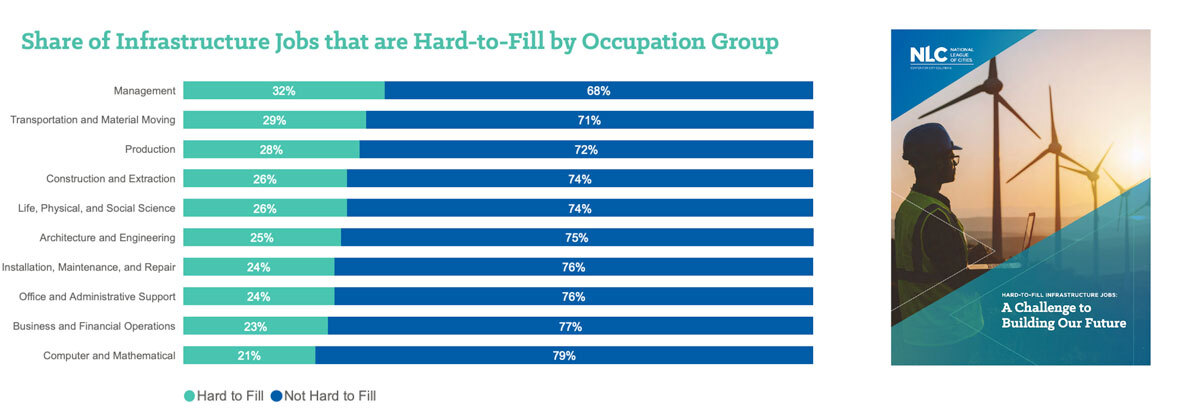Challenges to building our future
Our nation’s infrastructure is set to get a massive funding boost courtesy of the Federal government’s American Rescue Plan Act and bipartisan Infrastructure Investment and Jobs Act. In their new report entitled Hard-to-Fill Infrastructure Jobs: A Challenge to Building Our Future the National League of Cities explores the labor market’s readiness for the influx of infrastructure jobs that will be created by these new funding streams.

An infrastructure job is one in which the work required is related to the design, construction or maintenance of infrastructure. From January through April 2021, businesses in the U.S. listed more than 6.2 million jobs. Nearly 650,000, or over 10% of them, were infrastructure related. Using LinkUp data from that period to analyze open and close dates for infrastructure job listings, the National League of Cities’ report clearly shows how these jobs are far more difficult to fill than jobs in other industries, across all regions and cities of all different sizes.
According to the report, the median time-to-fill for an infrastructure job is 23 days, and just 19 days for a job not related to infrastructure. 30% of infrastructure jobs can be designated “hard-to-fill” (in that they, logically, take longer than expected to fill) whereas only 24% of all other non-infrastructure jobs are given the same hard-to-fill designation. The report also found that some infrastructure jobs were harder to fill than others, with 32% of infrastructure-related management positions left open for more than 45 days.

Images from National League of Cities
Difficulty in filling certain jobs may be explained by anything from a shortage of available workers, to a lack of clear career pathways, to misalignment between workforce programs and the actual demands of the industry. Retirements of skilled and semi-skilled workers are likely to become a major challenge for infrastructure jobs in the near future. At last estimate, over 2.7 MILLION infrastructure workers have retired over the last decade alone.
This impending shortage of workforce serves to highlight the need for investment in education and upskilling in these sectors. Creating strong pathways within the sector creates opportunities at all levels for career advancement and opens up more entry-level positions, which have lower barriers to entry. While the vast majority of infrastructure jobs require some level of education and training beyond high school, 60% of infrastructure jobs require 6 months of training or less.
With the report uncovering the broad range of factors potentially affecting employers’ ability to fill infrastructure jobs, policy makers and partners would be wise to carefully consider why key jobs are hard to-fill in their communities and regions. Addressing key issues now and ensuring that workforce strategies are part of their overall infrastructure planning can put communities in a better position to maximize federal infrastructure investment dollars, as well as strengthen economies by matching workers with infrastructure jobs.
See the full National League of Cities report with this easy download. And contact us if you’d like to learn more about the job market data behind this report.
Insights: Related insights and resources
-
Blog
08.27.2019
Crops are growing, agriculture hiring is not
Read full article -
Blog
06.05.2019
Cannabis Jobs, High On Success
Read full article -
Blog
09.28.2017
LinkUp Forecasting Net Gain of 260,000 Jobs For September
Read full article -
Blog
09.21.2017
Cities: Courting Amazon? Show them the numbers!
Read full article -
Blog
07.27.2017
LinkUp's June Jobs Data Indicates Decent Job Gains In July
Read full article -
Blog
03.01.2017
LinkUp Predicts Disappointing Jobs Report For February But March Should Be Better
Read full article
Stay Informed: Get monthly job market insights delivered right to your inbox.
Thank you for your message!
The LinkUp team will be in touch shortly.
